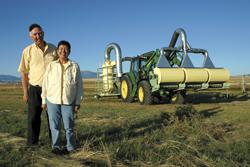
Most native grass seeds are hard to harvest and naturally shatter quickly once they are mature. Lee and Maggie Arbuckle, Montana ranchers, figured out how to harvest more species with a "combine" that uses counter-rotating comb and brush drums, and a vacuum.
"Our Seedster seed harvester plucks the seed from the seed head with almost no chaff," says Lee Arbuckle. "The plant is left intact for wildlife cover and soil protection."
The Seedster mounts on a tractor loader and consists of rotating combs that position and hold seed stems. A rapidly rotating brush dislodges all ripe seed. Dislodged seed is drawn by a vacuum through a tube and a cyclone separator before being bagged on a trailer behind the tractor.
The cyclone dumps seed through a steel bagging cylinder. The operator clamps a large seed bag over the cylinder to fill with several hundred pounds of seed. The cylinder is hinged to swing back for bag unloading. One side of the floor of the trailer hinges down, allowing the full seed bag to slide to the ground.
Currently most grass seeds are harvested by either combines or strippers, and neither is very effective with many species of native seed. There are two types of seed heads or "inflorescence". The easiest to harvest are species with a spike inflorescence. This leads to extensive use of them in re-seeding and reclamation efforts.
Panicle inflorescence seed heads are harder to harvest, as they can be shatter-prone, difficult to dislodge and separate. Even off-loading a full hopper can require a lot of manual assistance. However, panicle inflorescence species are far more common in nature and best adapted for many circumstances.
Range scientist Dr. Brian Sindelar is a key team member of the Seedster effort. He points to Western coal land reclamation as an example of limited species re-seeding. Seven to ten native and introduced species, mostly spike inflorescence, have been used over the years, although there are over 60 native grass species in the region.
Producer and machine developer Arbuckle says the Seedster will expand the number of species that can be easily harvested and made available for re-seeding. Producers who grow those species will be able to collect a higher percentage of seed at a much higher ground speed. This will increase the income of grass producers and native seed collectors.
He points to prices of for panicle inflorescence seeds. He says the Seedster can often recover 50 to 60 percent more seed than other harvesters. In a large field that may be enough to pay for the machine in one year. In some cases the Seedster can harvest species "unharvestable" by other machines. It also covers acres faster, which is important in crops with a brief harvest window.
"A standard combine must process a large volume of plant material, and because the densities of chaff and seed are so similar, the combine must slow down to one to two miles per hour or less," explains Arbuckle. "We can run as high as five miles per hour."
Speed at harvest is doubly important due to the tendency for seed to shell out due to wind or rain when ready for harvest. Higher ground speed multiplies the acres that can be harvested before seed has naturally dispersed.
The design of the Seedster ensures that easily shattered seed is captured. The counter rotating combing drum and brush create an air current that moves seeds into the vacuum flow. Less seed falls to the ground.
Dr. Sindelar has conducted extensive field trials for the Arbuckle team. On green needlegrass, a species where only 50 percent recovery of total seed is common, seed recovery by the Seedster at optimal settings reaches 335 lbs. (85 percent) from a field where hand harvested control plots yielded 395 lbs./acre.
"The rapidly counter-rotating cylinders result in 95 to 99 percent pure seed and 1 to 5 percent chaff from most panicle inflorescence species", says Arbuckle. "It gently removes the ripe seeds and even those with a little bit of moisture, but leaves the unripe seeds."
Since the pto powers separate hydraulic pumps for the fan, brush and combing drum motors, rpm can be finely calibrated. With other calibrations, the Seedster can adapt to very different grass plants and seed shapes. He notes that strippers in the industry use either brushes or combs, but the Seedster is the first to use both in cooperating action. The Arbuckles have patented the technology.
Arbuckle says different brushes and drums will be offered for different types of seeds, not just grasses. The Seedster is designed with three 40-in. comb brush modules which can be sized up or down.
"We will build the Seedster in Billings, Montana and ship direct," he says. "We estimate the Seedster will require about an 80 hp tractor to operate a 10-ft. wide machine. All a farmer will need is a tractor with pto and loader arms."
